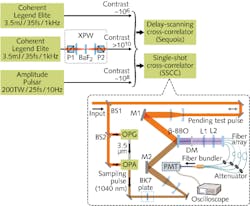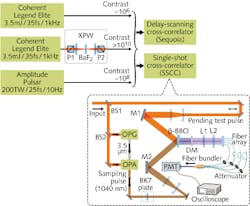Single-shot cross-correlator has >1010 dynamic range
For high-peak-power laser experiments with intensities greater than 1020 W/cm2, a temporal contrast—the ratio of optical noise or pre-pulse to the primary laser pulse peak intensity—of >109 is highly desirable to avoid unwanted perturbation of a fragile target or pre-plasma formation before the arrival of the main pulse. Now, scientists at Fudan University (Shanghai, China) have developed a single-shot cross-correlator (SSCC) that permits pulse-contrast measurement with a dynamic range higher than 1010, comparable to a delay-scanning cross-correlator (DSCC). The device is promising for constructing and optimizing ultra-high peak-power laser systems.
The SSCC uses both scattering-noise reduction and sensitive parallel detection to achieve high dynamic range. To suppress measurement contamination by air scattering of the signal peak, mirrors are placed right after the crystal to greatly reduce the main peak of the sum-frequency signal in space. The spatially distributed sum-frequency signal is then imaged by a cylindrical lens onto a fiber array consisting of 100 fibers with different lengths (~1 m increments between successive fibers), and converted into a series of temporally separated pulses that are captured by a high-sensitivity photomultiplier tube (Hamamatsu H10721-210). To measure the pulse-contrast dynamic range at an approximate value of 1010, a set of fiber attenuators (20 dB) is applied to the fiber-array detection system to accommodate to the dynamic range of the PMT, the output of which is displayed on a 300 MHz oscilloscope. Comparison of the SSCC and a standard DSCC carried out on a 200 TW Ti:sapphire laser verifies the high-dynamic-range performance of the SSCC. Reference: Y. Wang et al., Sci. Rep. 4, 3818 (January 22, 2014).

